China
Before heading out to our final sacred Taoist mountain of China, we stayed a couple days in Xi'an to enjoy the food and see the famous Terra Cotta Warriors. This amazing archaeological site was discovered in 1974 by some farmers digging a well. Now uncovered and reconstructed, the site displays 8,099 larger than life figures of warriors and horses. And, this is under half of the total painted terra cotta figures. The rest are still under ground! 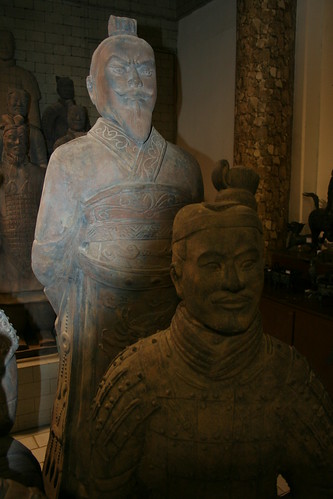 Each figure is unique, shaped after a real soldier in the First Qin Emperor's army. They were all buried to guard the Mausoleum of the Emperor. The figures vary in height according to their rank; the tallest being the Generals. The place is huge!
Each figure is unique, shaped after a real soldier in the First Qin Emperor's army. They were all buried to guard the Mausoleum of the Emperor. The figures vary in height according to their rank; the tallest being the Generals. The place is huge! 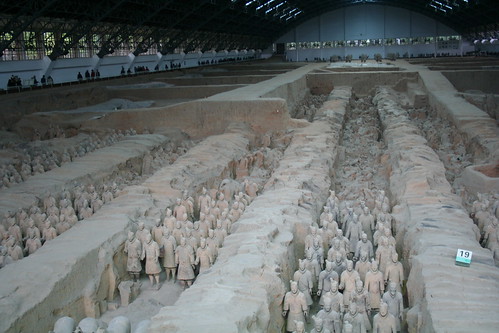
From Xi'an, we flew to Nanchang City, in the Jiangxi province. This city is famous for it's role in consolidating the power of the Communist Party. It is mostly classic ugly Communist-highrise architecture, but the peaceful Gan River (Gan Jiang) runs gracefully through it's center, and all sorts of great antique artwork can be found in it's shops. [We were a public security risk]
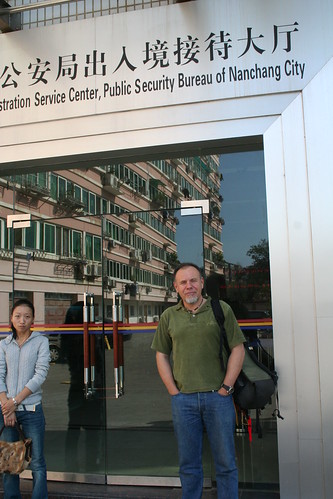
From there we caught the train to Yingtan, and a taxi to the main tourist entrance to Longhushan, which is now a "National Geopark of China". The place looks like a tropical Meteora; great rounded boulders poking through the plane.
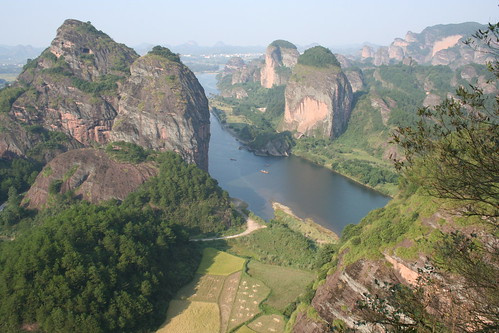
Longhushan means "Dragon and Tiger Mountain". It is said that a gust of wind moans over the empty valley when a tiger growls. In the middle of the East Han Dynasty, the first Tian Shi (Taoist priest ), Zhang Daoling张道陵(AD 34-156), started to distill elixirs here. According to the record, when the elixirs were made, a dragon and a tiger were seen winding above the oven. The mountain was named after the celestial animals.
This group of rocky spires are considered the cradle of formalized Taoism because Zhang Daoling created and practiced it here. [ Please read the intro to Taoist Mtns in China blog if you have not already ] The monks of Mount Longhushan led the Taoism schools in southern china, it became the centre of development of Chinese Taoism.

Now, it is a centre of Chinese Tourism. We passed through the obligatory trinket and souvenir shops to the park gate, where we paid our first entrance fee. From there we were ushered to the boat dock where we got our first view of the dramatic landscape.
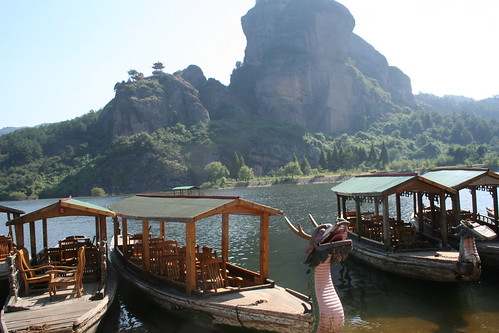 There were several men repairing longboats, and a desk where we paid our next fee for a boat ride up the river and to the various trailheads on our tourist map. We got boat tickets, and thought we would have a long boat to ourselves, but we were piled in with a Chinese tour group. Now, as mentioned in previous blogs, the Chinese have a different sense of appropriate volume. As we were polled up the quietly flowing river, in a small boat where normal voices could be heard easily, Rod and I almost pee'd our pants with what happened next. The tour guide stood up in the front of the boat, pulled out a megaphone, and began an extended natural history talk (in Chinese) at volume 11! It was too much!!
There were several men repairing longboats, and a desk where we paid our next fee for a boat ride up the river and to the various trailheads on our tourist map. We got boat tickets, and thought we would have a long boat to ourselves, but we were piled in with a Chinese tour group. Now, as mentioned in previous blogs, the Chinese have a different sense of appropriate volume. As we were polled up the quietly flowing river, in a small boat where normal voices could be heard easily, Rod and I almost pee'd our pants with what happened next. The tour guide stood up in the front of the boat, pulled out a megaphone, and began an extended natural history talk (in Chinese) at volume 11! It was too much!!
When the long boat dropped us off, we walked up stream and across a bridge to the beginning of a series of trails shown on our map. We stratigerized about the best walking route to see all the major shrines and temples, and started up an empty road. Soon we arrived back at the river... a dead end. Here was a military outpost and the gates to a military base. No, I guess we can't walk through the trails shown on the tourist map (I wonder if they think no one will do any walking, tourists just ride the boats, so they can offer trails that don't exist?). But the soldier we talked to was really nice, and offered us a ride back to the boat dock on his old Chinese copy of Ural motorcycle, which is a Russian copy of a WWII BMW. I rode in the sidecar!
We dutifully did not try to walk anywhere else, and got onto the next bamboo raft back down river. The bamboo raft dropped us off at a beach under the Cliff Tombs.
 High up on the cliff sides, the many caves were filled with wooden coffins and offerings. These tombs were used in the "Spring and Autumn Period(770-476 BC) and the Warring States Period(475-221 BC)". As is typical of major contemporary religious sites, what became known as a Taoist sacred site had already been sacred for the native religions of the area for a long time.
High up on the cliff sides, the many caves were filled with wooden coffins and offerings. These tombs were used in the "Spring and Autumn Period(770-476 BC) and the Warring States Period(475-221 BC)". As is typical of major contemporary religious sites, what became known as a Taoist sacred site had already been sacred for the native religions of the area for a long time. 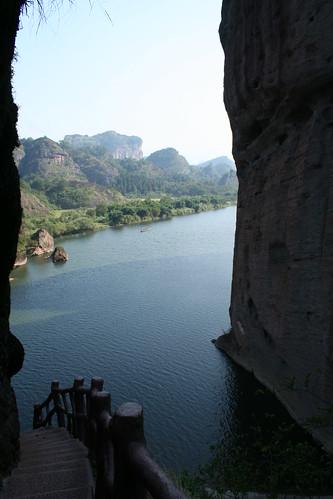
From the tombs and fairae cliff (the fairae who could not be married), we walked up the Celestial City Track, paid another entrance fee, and up to the Temple on the mountain top. The Grand Supreme Purity Palace, built over the original site of Taoism creation, is considered the place where all gods received their official ranks. It was built in the East Han Dynasty. Just under this temple, on the sheer cliff sides, are several caves perched above a path carved in the rock. This is the path of realization and it passes the caves of enlightenment, where it is said that various incarnations attained enlightenment throughout Taoist history.
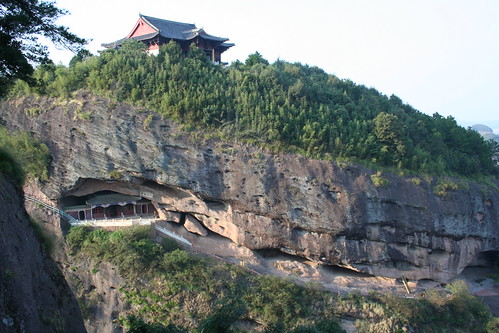
I could imagine monks sitting in meditation in these caves high above the river and rice paddies. In the amazing late afternoon light, a power was emanating from this pathway as we walked along it and back down to the valley floor.
 This is a hugely powerful spot, both in spirituality and historical importance. And once again, China has made it into a sight seeing spot for tourists, aggressively attempting to turn its religious significance into an oddity of the past. In fact, in the Chinese approved travel and tourist information, it is entitled "The best natural archaeological museum of China by Our Beautiful Motherland".
This is a hugely powerful spot, both in spirituality and historical importance. And once again, China has made it into a sight seeing spot for tourists, aggressively attempting to turn its religious significance into an oddity of the past. In fact, in the Chinese approved travel and tourist information, it is entitled "The best natural archaeological museum of China by Our Beautiful Motherland".Hmm... what can you do? Dragon and Tiger Mountain, LongHuShan, the end of our tour of the most sacred Taoist mountains of China. We got into a taxi at the bottom and headed back to Yingtan.
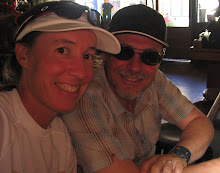
1 comment:
I want to go to China just as I want to get Generic Viagra. Thanks for sharing this.
Post a Comment